|
fashion: feature
 All in the jeans All in the jeans
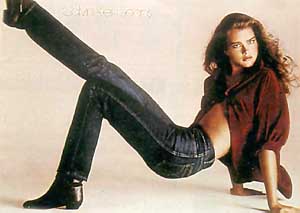
Sylvia
Giles examines the history of denim jeans in the context of popular
culture
Expanded from
issue 23 of Lucire
POPULAR CULTURE has a lot to answer
for. Of all the cultural carnage created for the sake of being popular
with the masses, fashion could be considered the worst offender.
Defined as the ‘culture of the people,’ it relies on mass communication,
mass media, mass recognition but most importantly, mass acceptance
of symbols and icons that are presented to us. It often involves
the use of icons that become so everyday their original meanings
are lost. While this certainly could be said of denim, the longevity
of its popularity has meant it has transcended all fads and fashions,
making it a fluid gauge of popular culture that has morphed and
reinvented to suit the requirements of an erratic society.
While everyone is all too familiar with the Levi
Strauss story, the influence of pop culture over denim includes
rock stars, artists, intellectuals and film stars, and began with
the emergence of the USA as a superpower
after World War II. This supremacy would slowly translate to dominance
of popular culture across the globe. Denim was quintessentially
American, typically branded and fundamentally mainstream. In its
early history, denim embodied the wholesome all-American hero, the
cowboy and the labourer. It was seen as having been bastardized
by biker gangs around the 1940s, and it was the first sight of what
would be a long-standing relationship between denim and the rebel.
Denim companies had a token attempt to portray themselves as a socially
responsible choice of apparel. In 1953, Lee ran its first advertisement
to teenage youth that promoted denim as an appropriate choice for
school, in response to the banning of denim in schools. But ultimately,
denim was to cash in on a rebellious youth and an American cultural
explosion.
It wasn’t until Marlon Brando endorsed jeans
with the kind of placement companies dream of in 1947. In A Streetcar
Named Desire on Broadway, and the resulting movie, jeans emerged
into the realm of pop culture. James Dean, Paul Newman and Marilyn
Monroe all reciprocated and jeans reached their cult status, with
associations of stardom and celebrity. Pop icons were also used
to export to other markets, such as ventures into France with Brigitte
Bardot, and her Italian equivalent Gina Lollobrigida.
It also became an icon of intellectuals, particularly
in New York, as early as the 1940s. In 1949 Jackson Pollock was
photographed for the cover of Life fittingly in paint splattered
denim, and began something of a craze within the world of abstract
expressions. The style was echoed by Andy Warhol, Roy Lichtenstein
and Saul Bellow. Warhol, in particular, was fastidious about his
jeans. He also went on to became the cover star for l’Uomo Vogue’s
special denim issue in 1980. He once said, ‘I wish I could invent
something like “blue jeans”. Something to be remembered for. Something
mass.’
During the 1970s, western pop culture’s influence
was being felt across the rest of the world. Within my parents’
library is a beautiful Russian book that my mother acquired while
on a train travelling through Russia. The currency for this book
was, in fact, her pair of Levi’s, spotted by a local passenger desperately
wanting them for ‘his girlfriend’. The trade took place. She still
treasures the book, and effortlessly bought a replacement pair on
her arrival back in the UK. The reality
is that in Russia in the 1970s, a pair of Levi’s could have reached
a much higher price than a paperback. Jeans had become a symbol
of western decadence because of the difficulty involved in getting
a pair in non-western countries. But that the demand existed at
all was an indication that the influence of western pop culture
was now sweeping across the entire globe.
Fashion took on a life of its own in the 1980s,
and the creation of pop culture-turned-monster. The cult of the
supermodel and celebrity reigned. In 1980, Calvin Klein used a 15-year-old
Brooke Shields to communicate the sexuality of jeans. The use of
the boldly stated line, ‘Between me and my Calvin’s there is absolutely
nothing … if they could talk I would be ruined,’ was married
with a provocative, leg-spread pose. The ad was pulled from many
television stations. Klein’s rebuttal was left at a ‘Jeans are sex.’
He hardly needed to say more. Conservative Middle America could
not tame the beast that had become pop culture, and Klein’s sales
leapt to $180 million a year. Likewise, fashion houses such as Versace
and Dior launched high-end denim wear lines, modelled only by supermodels
in sexual, powerful poses.
Music’s contribution to fashion is generally
a treasured one. As a true voice of the street, it is unlike the
devised marketing strategies in the name of consumerism. Music is
also, in general, more politically charged than the impression left
on pop culture by movie stars. Elvis, for example, refused to wear
jeans on stage, after having been schooled by black musicians in
Memphis, where denim rang of cotton fields and share cropping.
In 1975, in a small bar in New York called CBGB,
Television bassist Richard Hell graced the stage in a ripped T-shirt
and jeans. It was observed by a very impressed Malcolm McLaren,
who recreated the look with the Sex Pistols, with the help of Vivienne
Westwood. This was the beginning of the punk movement, which was
to take on a life of its own. Denim sat alongside leather, vinyl
and safety pins. While the untrained eye was to brand it an “uglification”,
punk communicated a deep dissatisfaction of a generation that felt
deeply let down by the world.
The Ramones, also Television fans, created a
variation of their own, teaming their jeans with black leather jackets
and white T-shirts. Their manager, Danny Fields, was also a figure
in the Andy Warhol Factory scene. He easily identified why their
look resonated with youths: ‘It’s an easy enduring look and costume
that any kid in the world can create. It’s the way you face the
street.’
If the pop culture influences on denim history
read like a Who’s Who of the 20th century, the 21st century
would signify a break-down of the concept of “the mainstream”, and
the emergence of subcultures and individualization. The internet
is now the ruling authority on pop culture. Information is traded
in an instant. It has reduced the cycles of fashion and fads, which
now happen instantaneously and the globe. But by far the most interesting
outcome has been the explosion of subcultures—a fragmentation of
the mainstream. If you put denim distressing into Google
you will find many a website and thread devoted to home ‘distresseurs’.
The most interesting include one fashion devotee that had buried
his jeans in his back yard for an entire year. After a wash they
came up better than jeans one might find in the scientific laboratories
of any well-known, excessively funded denim factory. Likewise, with
the recent tendency towards very blue denim with very little interference,
anecdotal evidence filters through the web of fashion victims refusing
to wash their jeans in an effort to keep them as authentic to the
original denim as possible. But giving a voice to the public that
sits on the same forum as fashion reviews from Paris, New York,
London, suddenly equates the consumer with the label, giving a new
voice and authority to fashion at the ground roots.
continued
Add
to Del.icio.us | Digg
it | Add
to Facebook
|
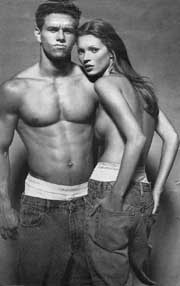
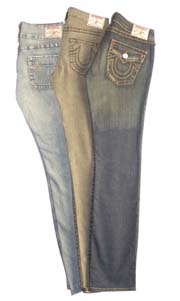
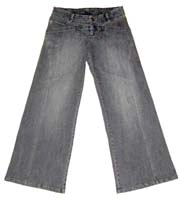
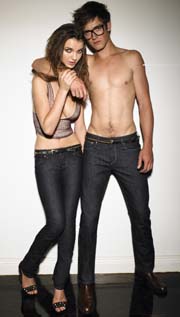
Main photograph: Brooke Shields in her Calvin Klein print ad.
From top: Kate Moss appears in another sexy Calvin Klein
jeans advertisement, pushing more boundaries. Jeans from Free Religion.
Doosh Roadrunner jeans in Smoke. Levi’s Super Fit.
Within my parents’ library is a beautiful Russian book that my
mother acquired while on a train travelling through Russia. The
currency for this book was, in fact, her pair of Levi’s, spotted
by a local passenger desperately wanting them for ‘his girlfriend’.
The trade took place
|

